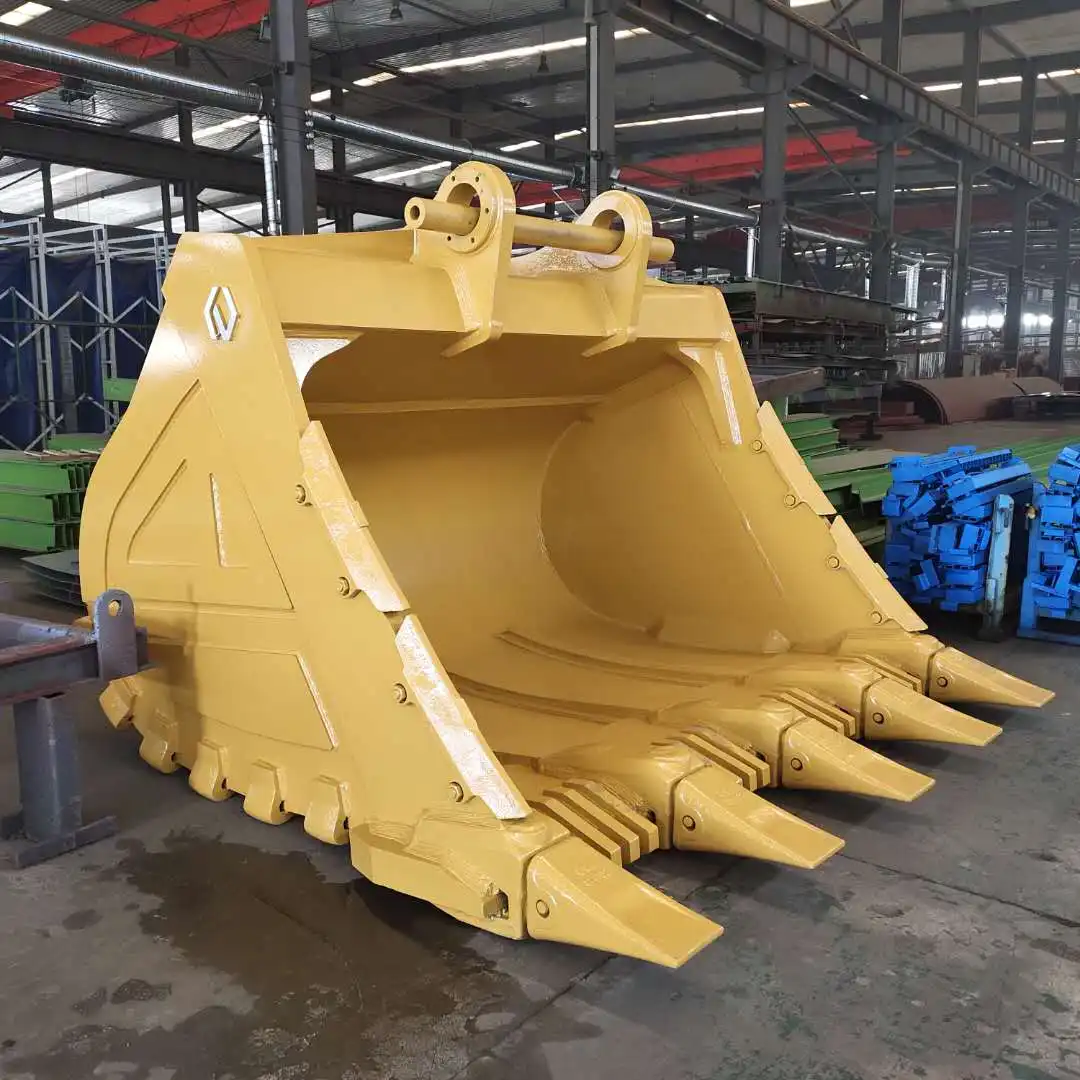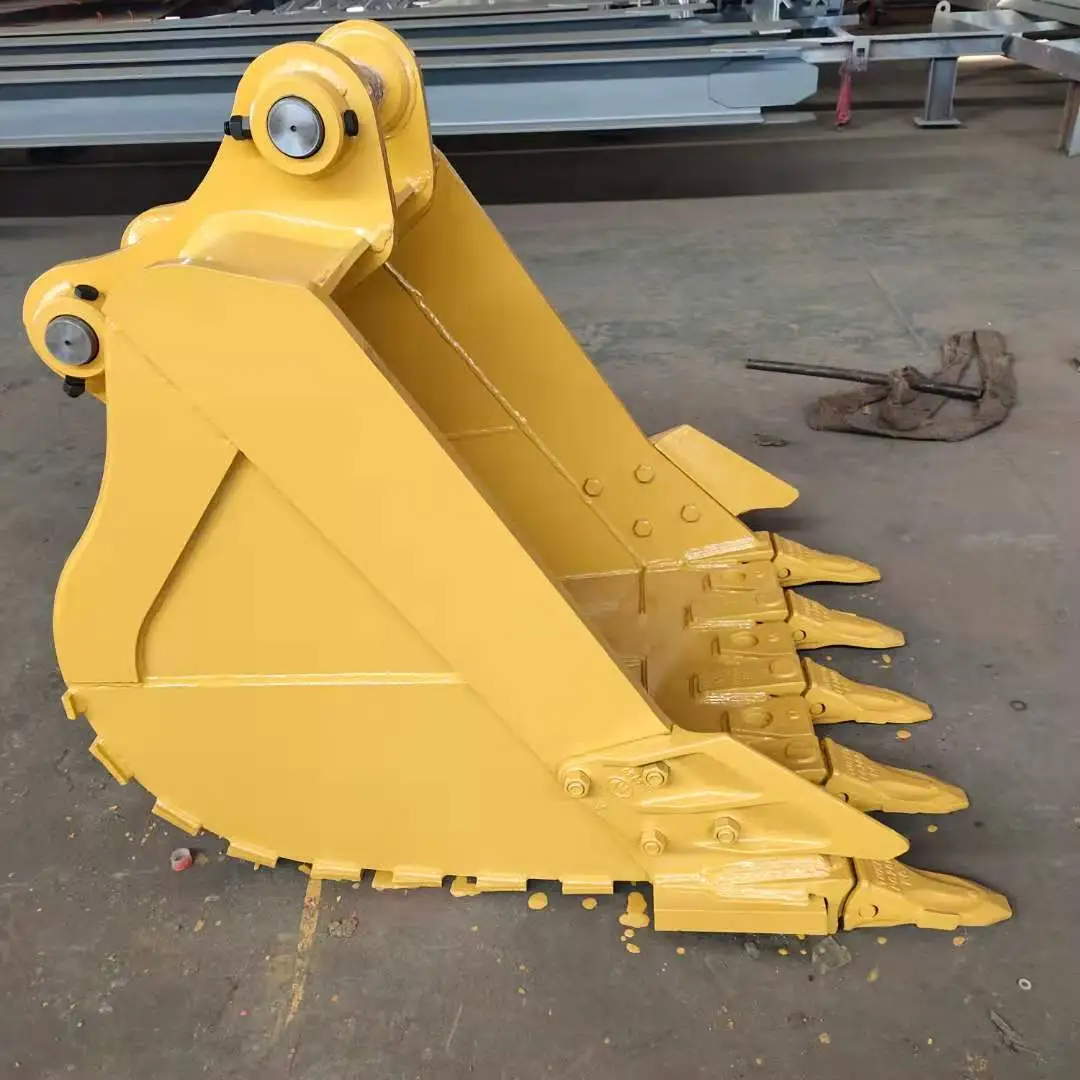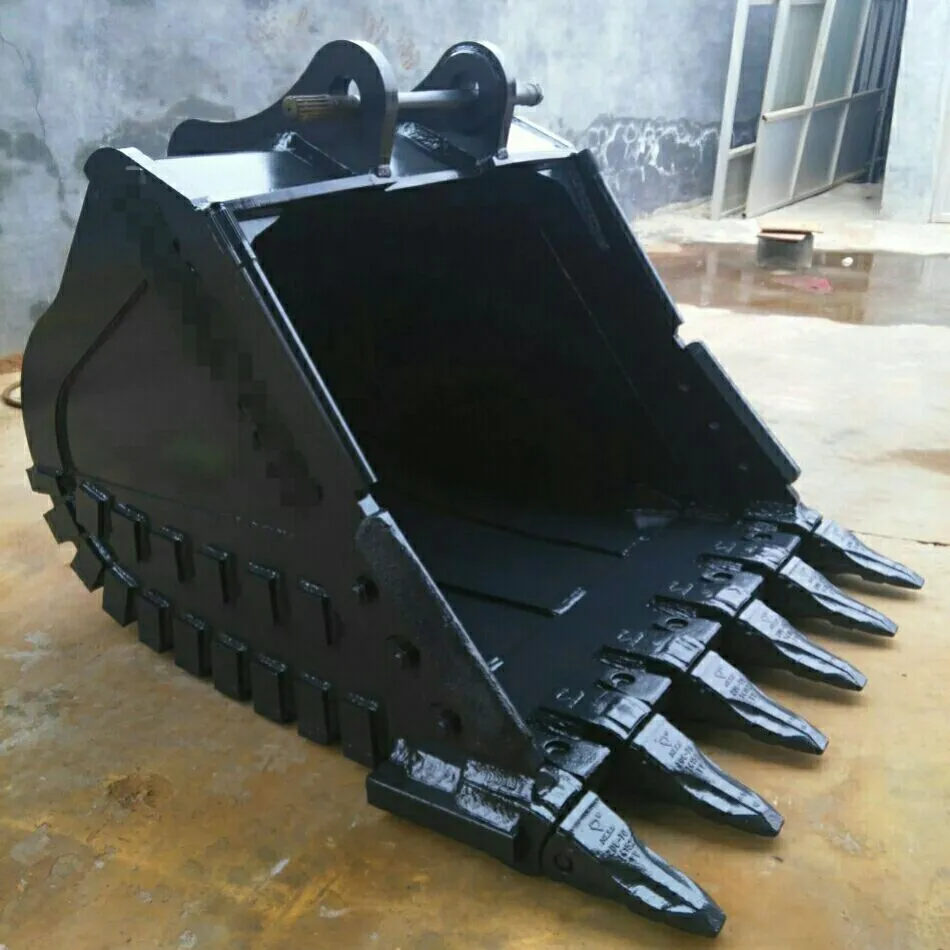How to improve excavator rock bucket durability?
Excavator rock buckets face extreme wear and tear in demanding environments. Improving their durability is crucial for maximizing efficiency and minimizing downtime in construction, mining, and demolition projects. To enhance the lifespan of your rock bucket, focus on three key areas: reinforcing with wear-resistant materials, maintaining bucket teeth, and avoiding overloading. By implementing these strategies, you'll significantly extend your bucket's service life, reduce replacement costs, and boost overall productivity on the job site.
Strengthen With Wear-Resistant Steel
The foundation of a durable excavator rock bucket lies in its construction materials. Upgrading to wear-resistant steel can dramatically extend the bucket's lifespan, even in the harshest working conditions. Let's explore three effective methods to reinforce your bucket:
Choose High-Quality AR500 Steel for Bucket Construction
AR500 steel is a game-changer in excavator rock bucket durability. This high-carbon, quenched and tempered steel boasts impressive hardness and abrasion resistance. When used in bucket construction, it significantly outlasts standard steel grades. The increased durability translates to fewer repairs and replacements, saving both time and money in the long run.
Many operators have reported up to 50% longer bucket life after switching to AR500 steel. While the initial cost might be higher, the extended service life and reduced downtime more than make up for the investment. When selecting a new bucket or planning a rebuild, prioritize AR500 steel for optimal performance in rocky terrains.
Reinforce High-Wear Areas with Hardox Overlay Plates
Even with a robust AR500 steel construction, certain areas of your excavator rock bucket will experience more intense wear. These high-stress zones, such as the bucket lips and side plates, benefit from additional reinforcement. Hardox overlay plates offer an excellent solution for these vulnerable areas.
Hardox, known for its exceptional hardness and toughness, can be welded onto existing bucket surfaces. This creates an extra layer of protection where it's needed most. The result? Significantly reduced wear rates and extended bucket life. Many operators have seen wear resistance improve by up to 400% in reinforced areas.
Implement Strategic Wear Strips for Extended Lifespan
Strategic placement of wear strips is another effective technique to boost excavator rock bucket durability. These strips, typically made from hardened steel or specialized wear-resistant alloys, are welded onto high-wear areas of the bucket. They act as sacrificial elements, taking the brunt of the abrasive forces and protecting the underlying bucket structure.
Properly installed wear strips can double or even triple the life of your bucket in extreme conditions. They're particularly effective on the bucket floor, side plates, and cutting edge. Regular inspection and timely replacement of these strips ensure consistent protection and performance.
By combining these three strengthening methods - using AR500 steel, reinforcing with Hardox plates, and implementing strategic wear strips - you create a formidable defense against wear and tear. This comprehensive approach significantly extends your excavator rock bucket's lifespan, reducing operational costs and boosting productivity.
However, material reinforcement is just one piece of the durability puzzle. Let's move on to another critical aspect: maintaining your bucket's teeth.

Regularly Replace Bucket Teeth
While strengthening your excavator rock bucket's body is crucial, the teeth are its front-line soldiers. They bear the brunt of the impact and abrasion during operation. Proper maintenance and timely replacement of bucket teeth are essential for preserving overall bucket performance and durability. Let's delve into three key practices for optimal tooth care:
Monitor Tooth Wear and Replace Before Performance Drops
Vigilant monitoring of tooth wear is the cornerstone of effective bucket maintenance. As teeth wear down, they become less effective at penetrating and breaking up material. This inefficiency puts extra stress on the entire bucket structure, potentially leading to premature wear or damage.
Establish a regular inspection routine, ideally before each shift. Look for signs of excessive wear, such as rounded or flattened tips, or teeth that have worn down to the adapter. When teeth have lost about 50% of their original length, it's time for replacement. Don't wait until performance noticeably drops - proactive replacement maintains efficiency and protects the bucket from unnecessary strain.
Use OEM-Specified Teeth for Optimal Fit and Function
When it comes to replacement teeth, opting for OEM (Original Equipment Manufacturer) specified parts is often the wisest choice. These teeth are designed to perfectly match your excavator rock bucket's specifications, ensuring optimal fit and function.
OEM teeth offer several advantages:
- Precise fit reduces the risk of teeth coming loose during the operation
- Engineered to work harmoniously with your specific bucket design
- Often made from high-quality, wear-resistant materials
- May come with warranties or guarantees
While aftermarket teeth might seem cost-effective initially, they can lead to poor performance, increased wear on the bucket, and potential safety hazards. The long-term benefits of OEM teeth typically outweigh any short-term savings.
Rotate Teeth to Ensure Even Wear Distribution
An often-overlooked tactic for extending tooth life is rotation. Not all teeth on an excavator rock bucket wear at the same rate. Corner teeth, for instance, often experience more wear than center teeth. By periodically rotating the positions of your bucket teeth, you can distribute wear more evenly across all teeth.
Implement a rotation schedule based on your specific operating conditions. In high-wear environments, you might rotate teeth weekly or bi-weekly. In less demanding conditions, monthly rotation might suffice. This practice not only extends the life of individual teeth but also maintains consistent bucket performance over time.
Remember, well-maintained teeth do more than just improve bucket durability. They also enhance digging efficiency, reduce fuel consumption, and minimize operator fatigue. By focusing on these three aspects of tooth care
- timely replacement, using OEM parts, and strategic rotation
- you're investing in the overall health and performance of your excavator rock bucket.
Now that we've covered strengthening techniques and tooth maintenance, let's explore another critical factor in bucket durability: proper loading practices.

Avoid Overloading
While robust construction and diligent maintenance are crucial, how you use your excavator rock bucket plays an equally important role in its longevity. Overloading is a common issue that can significantly reduce bucket lifespan and pose safety risks. Let's explore three strategies to prevent overloading and optimize your bucket's performance:
Adhere to Manufacturer's Recommended Load Capacity
Every excavator rock bucket is designed with specific load capacities in mind. These limits are not arbitrary - they're calculated based on the bucket's structural integrity, the excavator's lifting capacity, and safety considerations. Exceeding these limits puts undue stress on both the bucket and the machine, potentially leading to premature wear, structural damage, or even catastrophic failure.
Make sure all operators are familiar with the load capacity of each bucket in use. This information is typically available in the manufacturer's documentation or stamped on the bucket itself. Consider posting capacity information in the cab for easy reference. Remember, load capacity isn't just about volume - it also relates to the density of the material being handled. A bucket full of loose soil will weigh considerably less than the same volume of dense rock.
Train Operators on Proper Bucket Loading Techniques
Even within the recommended load capacity, how a bucket is loaded can impact its durability. Proper loading techniques distribute the load evenly, reducing stress on any single point of the bucket. Here are some key points to cover in operator training:
- Fill the bucket progressively from the bottom up, rather than trying to scoop large amounts in one go
- Avoid using the bucket to pry or lever material - this can cause twisting forces that stress the bucket structure
- When dealing with large rocks, position them carefully in the bucket rather than dropping them from a height
- Be mindful of the bucket's center of gravity when loading - uneven loading can cause instability and undue stress
Regular refresher training and performance monitoring can help ensure these best practices become second nature to your operators.
Implement Load Monitoring Systems for Excavator Buckets
Technology can be a powerful ally in preventing overloading. Load monitoring systems provide real-time feedback on bucket weight, helping operators make informed decisions during loading operations. These systems typically consist of sensors installed on the excavator's boom or bucket, connected to a display in the cab.
Advanced load monitoring systems offer features like: - Visual and audible alarms when approaching or exceeding load limits - Data logging for performance analysis and operator training - Integration with fleet management systems for remote monitoring
While there's an initial investment involved, load monitoring systems can pay for themselves through improved efficiency, reduced wear and tear, and enhanced safety. They're particularly valuable in operations handling varied materials or in training new operators.
By focusing on these three aspects - adhering to load capacities, training operators in proper techniques, and leveraging technology - you can significantly reduce the risk of overloading. This not only extends your excavator rock bucket's lifespan but also improves overall operational efficiency and safety.
Improving excavator rock bucket durability is a multifaceted approach that combines smart material choices, diligent maintenance, and mindful operation. By reinforcing your bucket with wear-resistant steel, regularly maintaining and replacing teeth, and avoiding overloading, you can significantly extend your bucket's lifespan. Remember, a durable bucket isn't just about reducing replacement costs - it's about maintaining peak performance, ensuring safety, and maximizing your equipment's productivity. Implement these strategies, and you'll see the benefits in both your bucket's longevity and your operation's bottom line.

FAQ
①How often should I inspect my excavator rock bucket for wear?
It's recommended to perform a visual inspection daily before operations begin. More thorough inspections should be conducted weekly or bi-weekly, depending on the intensity of use and the abrasiveness of the materials being handled.
②Can I repair a worn excavator rock bucket instead of replacing it?
Yes, in many cases, worn buckets can be repaired or rebuilt. This often involves welding new wear plates or reinforcing existing structures. However, there comes a point where replacement becomes more cost-effective than repair. Consult with a professional to assess the best option for your specific situation.
③How does the type of material being excavated affect bucket durability?
Different materials cause varying levels of wear. Highly abrasive materials like granite or quartzite will cause more rapid wear than softer materials like limestone or clay. Your bucket's design and materials should be matched to the primary type of material you're handling for optimal durability.
④Are there any special considerations for using excavator rock buckets in underwater operations?
Underwater use introduces additional challenges, including increased corrosion risk and potential cavitation damage. For submerged operations, consider buckets with additional corrosion-resistant coatings and ensure all seals and joints are properly maintained to prevent water ingress.
⑤How does bucket size affect its durability?
Generally, larger buckets experience more stress due to heavier loads and may wear faster. However, using a bucket that's too small for the job can lead to overloading and excessive wear. Always choose a bucket size appropriate for your excavator's capacity and the job requirements.
China Excavator Rock Bucket Supplier
TianNuo Machinery stands as a leading manufacturer of excavator rock buckets in China. With a comprehensive range of excavator accessories and modifications, TianNuo offers solutions tailored to various industries, including railway maintenance, construction, and mining. Their rock buckets are crafted from high-strength wear-resistant steel, available in capacities from 0.2 to 5.0 cubic meters, and are compatible with various excavator models. For those seeking durable, high-performance excavator attachments, you can contact us at raymiao@stnd-machinery.com.
References
- Smith, J. (2022). Advanced Materials in Excavator Bucket Design. Journal of Construction Engineering, 45(3), 112-125.
- Johnson, R., & Brown, T. (2021). Optimization of Excavator Bucket Teeth Replacement Schedules. International Journal of Mining Science and Technology, 31(2), 235-242.
- Lee, S., et al. (2023). Impact of Operator Training on Excavator Efficiency and Equipment Longevity. Construction Management and Economics, 41(5), 478-490.
- Wilson, M. (2022). Wear-Resistant Alloys in Heavy Equipment: A Comparative Study. Materials Science and Engineering: A, 832, 142357.
- Thompson, K. (2021). Load Monitoring Technologies in Excavation: Current Trends and Future Prospects. Automation in Construction, 130, 103838.
- Chang, L., & Davis, R. (2023). Life Cycle Analysis of Excavator Attachments in High-Wear Environments. Resources, Conservation and Recycling, 188, 106644.
About Author: Arm
Arm is a leading expert in the field of specialized construction and railway maintenance equipment, working at Tiannuo Company.

